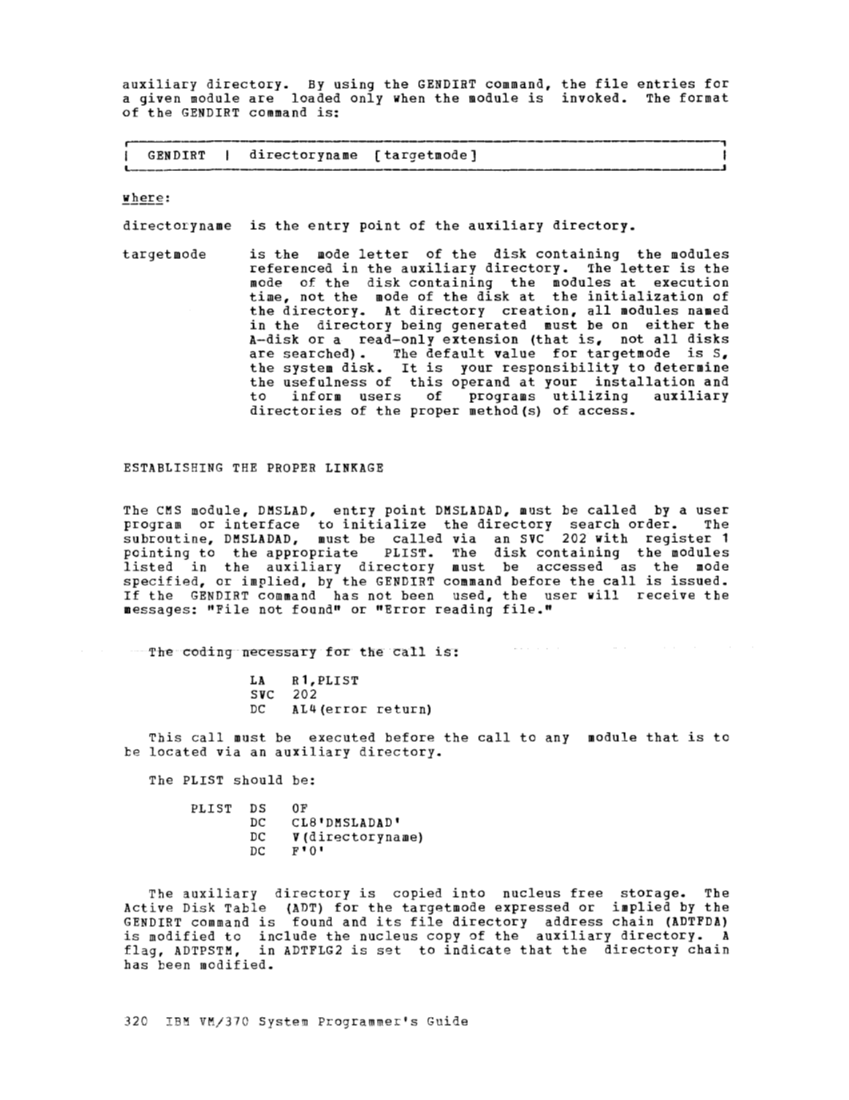auxiliary directory. By using the GENDIRT command, the file entries for
a given module are loaded only when the module is invoked. The format
of the GENDIRT command is:
GENDIRT directoryname [targetmode]
directoryname is the entry point of the auxiliary directory.
target mode is the mode letter of the disk containing the modules
referenced in the auxiliary directory. The letter is the
mode of the disk containing the modules at execution
time, not the mode of the disk at the initialization of
the directory_ At directory creation, all modules named
in the directory being generated must be on either the
A-disk or a read-only extension (thatis, not all disks
are searched)• The default value for targetmode is S, the system disk. It is your responsibility to determine
the usefulness of this operand at your installation and
to inform users of programs utilizing auxiliary
directories of the proper methodes) of access.ESTABLISHING THE PROPER LINKAGE
TheCMS module, DMSLAD, entry point DMSLADAD, must be called by a user
program or interface to initialize the directory search order. The
subroutine,DMSLADAD, must be called via an SVC 202 with register 1
pointing to the appropriatePLIST. The disk containing the modules
listed in the auxiliary directory must be accessed as the mode
specified, or implied, by the GENDIRT command before the call is issued.
If the GENDIRT command has not been used, the user will receive the
messages: "File not found" or "Error reading file."Th-e coding necessary for the call is: LA R1,PLIST SVC 202 DC AL4(error return)
This call must be executed before the call to any module that is to
be located via an auxiliary directory.
ThePLIST should be: PLIST DS DC
DC
DCOF CL8'DMSLADAD' V (d irectoryname) F'O' The auxiliary directory is copied into nucleus free storage. The
Active Disk Table (ADT) for the targetmode expressed or implied by the
GENDIRT command is found and its file directory address chain (ADTFDA)
is modified to include the nucleus copy of the auxiliary directory. A
flag,ADTPSTM, in ADTFLG2 is set to indicate that the directory chain
has been modified.320 IBM VM/370 System Programmer's Guide
a given module are loaded only when the module is invoked. The format
of the GENDIRT command is:
GENDIRT directoryname [targetmode]
directoryname is the entry point of the auxiliary directory.
target mode is the mode letter of the disk containing the modules
referenced in the auxiliary directory. The letter is the
mode of the disk containing the modules at execution
time, not the mode of the disk at the initialization of
the directory_ At directory creation, all modules named
in the directory being generated must be on either the
A-disk or a read-only extension (that
are searched)
the usefulness of this operand at your installation and
to inform users of programs utilizing auxiliary
directories of the proper methodes) of access.
The
program or interface to initialize the directory search order. The
subroutine,
pointing to the appropriate
listed in the auxiliary directory must be accessed as the mode
specified, or implied, by the GENDIRT command before the call is issued.
If the GENDIRT command has not been used, the user will receive the
messages: "File not found" or "Error reading file."
This call must be executed before the call to any module that is to
be located via an auxiliary directory.
The
DC
DC
Active Disk Table (ADT) for the targetmode expressed or implied by the
GENDIRT command is found and its file directory address chain (ADTFDA)
is modified to include the nucleus copy of the auxiliary directory. A
flag,
has been modified.















































































































































































































































































































































































































































